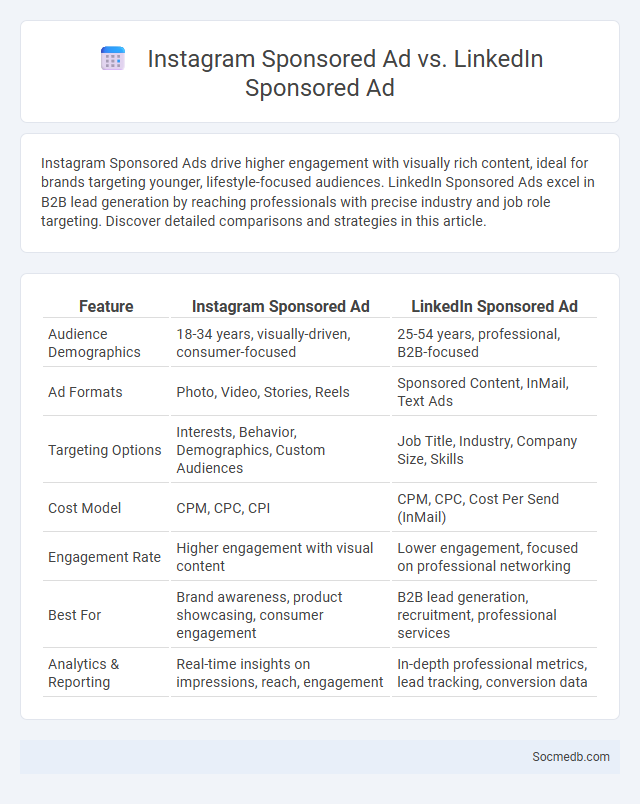
Photo illustration: Instagram Sponsored Ad vs LinkedIn Sponsored Ad
Instagram Sponsored Ads drive higher engagement with visually rich content, ideal for brands targeting younger, lifestyle-focused audiences. LinkedIn Sponsored Ads excel in B2B lead generation by reaching professionals with precise industry and job role targeting. Discover detailed comparisons and strategies in this article.
Table of Comparison
| Feature | Instagram Sponsored Ad | LinkedIn Sponsored Ad |
|---|---|---|
| Audience Demographics | 18-34 years, visually-driven, consumer-focused | 25-54 years, professional, B2B-focused |
| Ad Formats | Photo, Video, Stories, Reels | Sponsored Content, InMail, Text Ads |
| Targeting Options | Interests, Behavior, Demographics, Custom Audiences | Job Title, Industry, Company Size, Skills |
| Cost Model | CPM, CPC, CPI | CPM, CPC, Cost Per Send (InMail) |
| Engagement Rate | Higher engagement with visual content | Lower engagement, focused on professional networking |
| Best For | Brand awareness, product showcasing, consumer engagement | B2B lead generation, recruitment, professional services |
| Analytics & Reporting | Real-time insights on impressions, reach, engagement | In-depth professional metrics, lead tracking, conversion data |
Introduction to Sponsored Ads: Instagram vs LinkedIn vs General
Sponsored ads on Instagram leverage highly visual content to engage users through Stories, Reels, and Feed placements, targeting audiences based on detailed demographic and interest data. LinkedIn sponsored ads emphasize professional networking, allowing you to reach decision-makers and industry-specific groups with tailored content formats like Sponsored Content, InMail, and Dynamic Ads. General social media sponsored ads combine broad platform capabilities, offering customizable targeting options and analytics to optimize your campaign performance across diverse user bases.
Audience Targeting Capabilities: Instagram vs LinkedIn
Instagram offers advanced audience targeting capabilities through detailed demographic, interest, and behavior data, enabling You to reach younger, visually-oriented users with precision. LinkedIn excels in professional audience targeting, allowing advertisers to filter by job title, industry, company size, and seniority, making it ideal for B2B marketing and recruitment efforts. Both platforms utilize robust targeting tools, but Instagram focuses on consumer lifestyle segmentation while LinkedIn emphasizes career-related attributes.
Ad Formats and Creative Options Compared
Social media platforms offer diverse ad formats including image, video, carousel, and story ads, each tailored to engagement goals and user behavior. Video ads typically generate higher click-through rates and brand recall compared to static images, while carousel ads enable showcasing multiple products or features in a single interactive post. Creative options such as augmented reality filters, shoppable posts, and dynamic ads enhance user interaction and personalized targeting, increasing conversion potential across platforms like Facebook, Instagram, and TikTok.
Cost and ROI Analysis: Instagram, LinkedIn, and General Platforms
Instagram offers high engagement rates and visual appeal, making it ideal for brands targeting younger demographics, with average cost per click (CPC) around $0.70 to $1.00 and return on investment (ROI) varying by campaign goal. LinkedIn provides precise B2B targeting and higher conversion quality, often with a higher CPC of $5 to $8 but greater lead quality that boosts overall ROI for professional services. General social media platforms present a wide range of costs and outcomes, where strategic budget allocation and platform-specific performance tracking are essential to maximize ROI.
Engagement Metrics: Which Platform Performs Better?
Engagement metrics such as likes, shares, comments, and click-through rates vary significantly across social media platforms, with Instagram and TikTok showing higher average engagement rates per post compared to Facebook and Twitter. Instagram's visual-centric approach drives interaction, especially among younger demographics, while TikTok's short-form video format generates viral engagement through its algorithmic content discovery. Analyzing platform-specific metrics reveals that brands targeting high engagement should prioritize Instagram for photos and Stories, and TikTok for dynamic video content to maximize user interaction.
Industry Suitability: Where Each Platform Excels
Instagram excels in visual storytelling for fashion, travel, and food industries due to its image-centric design and engagement tools like Stories and Reels. LinkedIn is ideal for B2B companies, recruitment agencies, and professional services, offering advanced networking features and content tailored for industry insights and thought leadership. TikTok suits entertainment, lifestyle brands, and small businesses targeting younger demographics with highly engaging, short-form video content driving virality and brand awareness.
Platform Algorithm and Ad Delivery Differences
Social media platforms use distinct algorithms to curate content, influencing which posts appear in Your feed based on engagement metrics, relevance, and user behavior patterns. Ad delivery systems vary across platforms, optimizing based on targeting options like demographics, interests, and real-time bidding processes to maximize campaign effectiveness. Understanding these differences helps you tailor strategies for higher visibility and improved ad performance.
User Intent and Advertising Success Rates
Social media platforms leverage user intent data to enhance advertising success rates by targeting users based on their online behaviors and preferences. Accurate interpretation of user intent enables advertisers to deliver personalized ads that resonate with potential customers, resulting in higher click-through and conversion rates. Optimizing campaigns with intent signals like search queries, browsing history, and engagement patterns significantly boosts return on investment for social media advertising efforts.
Case Studies: Brand Results Across Platforms
Case studies on social media demonstrate significant brand growth metrics across platforms like Instagram, Facebook, and TikTok, highlighting increases in engagement rates by up to 75% and conversion rates exceeding 30%. Brands leveraging data-driven strategies have reported heightened audience targeting precision, resulting in a 50% boost in ROI within six months. Analyzing user behavior and content performance in these case studies reveals critical insights that drive effective social media marketing campaigns.
Choosing the Right Sponsored Ad for Your Marketing Goals
Choosing the right sponsored ad on social media depends on your marketing goals, whether aiming for brand awareness, lead generation, or conversions. You should analyze platform-specific ad formats, such as Facebook's carousel ads for showcasing multiple products or Instagram's story ads for immersive experiences. Optimizing your ad choice based on audience targeting and campaign objectives boosts your chances of achieving measurable success.
 socmedb.com
socmedb.com